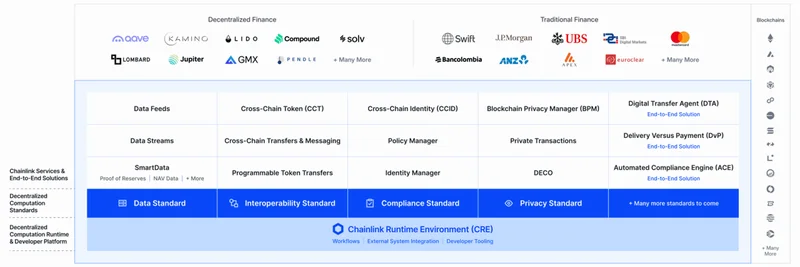In the wild world of crypto, where memes can pump prices overnight and narratives drive billion-dollar valuations, a recent tweet from ChainLinkGod has reignited the age-old rivalry between Chainlink ($LINK) and XRP. If you're new to this, Chainlink is a decentralized oracle network that feeds real-world data into smart contracts on blockchains, essentially acting as a bridge between the blockchain and external data sources. XRP, on the other hand, is the native token of the XRP Ledger (XRPL), designed primarily for fast and cheap cross-border payments, often touted as a tool for banks and institutions.
The tweet, posted on August 19, 2025, quotes an interview clip from Andy (@ayyyeandy) where he asks ChainLinkGod about the "$XRP vs. $LINK war." ChainLinkGod doesn't mince words: "$XRP vs $LINK is a perfect encapsulation of narrative vs reality." He points out how XRP has been hyping institutional adoption for over a decade, with communities often fed misinformation and confused by things like unit bias— that's when people think a coin is cheaper just because its price per unit is lower, ignoring the total market cap.
Contrast that with Chainlink, which he says is "verifiably working with the largest institutions in the world" on blockchain and tokenized assets. Tokenized assets? Think real-world things like stocks, bonds, or even real estate turned into digital tokens on the blockchain for easier trading and ownership. Chainlink's platform handles everything from data delivery to cross-chain transfers, and it's already powering most of DeFi (Decentralized Finance, where financial services run on blockchains without middlemen).
He wraps it up by saying this "narrative disconnect will not last forever." You can check out the full tweet here.
The Interview That Sparked It All
The quoted post includes a video from @ayyyeandy's show, where ChainLinkGod expands on his views. In the clip, he mentions how the debate dates back to 2019 and boils down to who's better positioned for institutional blockchain adoption. He criticizes XRP's long-standing promises of bank partnerships hidden behind NDAs (Non-Disclosure Agreements), contrasting it with Chainlink's public collaborations with giants like Swift, JP Morgan, and UBS. These aren't ancient PDFs or rumors—these are recent, direct confirmations from the institutions themselves.
It's a compelling watch, clocking in at about a minute and a half, and it perfectly sets the stage for why narratives can sometimes overshadow actual progress in crypto.
Diving Deeper: Chainlink's Edge in a Multi-Chain World
ChainLinkGod links to an earlier thread for more details, where he argues that while XRP and Chainlink aren't direct competitors, Chainlink benefits from any blockchain adoption, public or private. It's chain-agnostic, meaning it works across multiple networks, securing over $92 billion in value across 60+ blockchains. XRPL, by comparison, has a DeFi total value locked (TVL) of just $100 million—about 1,000 times less.
Here's a visual from that thread illustrating Chainlink's comprehensive platform:
This diagram shows how Chainlink provides standards for data, interoperability, compliance, privacy, and more, integrating with players like Aave, Swift, and Mastercard. It's a unified stack for tokenizing trillions in assets, regardless of the underlying blockchain.
Community Reactions: From Memes to Heated Debates
As expected in crypto Twitter (now X), the tweet drew a mix of support, criticism, and even some memes. One reply from @keetamaxi25 promotes Keeta ($KTA) as a superior alternative, claiming it replaces both XRP and Chainlink with better scalability and compliance. Another user, @ExtantBuffalo, dismisses Chainlink as a "tiny niche coin on the ETH network," missing its multi-chain nature entirely—ChainLinkGod quickly corrects that outdated view.
Then there's @BANK12260260, who calls the take "retarded" and points to XRP's larger market cap, accompanied by this classic meme:
It's a reminder of how toxic debates can get, but also how memes fuel the fire in these discussions. Other replies accuse ChainLinkGod of FUD (Fear, Uncertainty, Doubt), claiming XRP has been tested by over 1,700 institutions over the years.
Why This Matters for Meme Tokens and Crypto Enthusiasts
At Meme Insider, we focus on meme tokens because they embody the power of narratives—think Dogecoin or PEPE, where community hype and memes drive value more than tech specs. But this $LINK vs $XRP saga shows the flip side: when narratives diverge from reality, corrections can be brutal. For meme token holders, it's a lesson in discerning hype from substance. While memes can create short-term pumps, long-term success often hinges on real utility, like Chainlink's role in enabling secure DeFi and RWA (Real-World Asset) tokenization.
If you're building or investing in blockchain projects, Chainlink's approach—focusing on verifiable partnerships and a modular, chain-agnostic platform—could be a blueprint. Meanwhile, XRP's community remains passionate, betting on its payment prowess to shine through.
As ChainLinkGod says, the disconnect won't last forever. In crypto, reality eventually catches up to the narrative. Keep an eye on institutional moves; they might just dictate the next big winners. What do you think—team $LINK or $XRP? Drop your thoughts in the comments!


